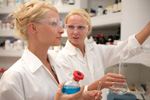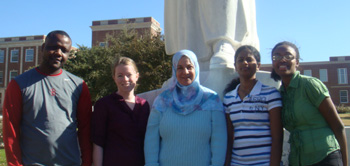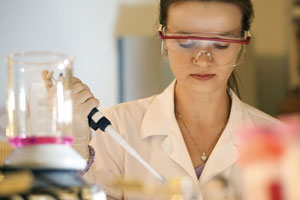Great research can start anywhere including your own undergraduate laboratory, as recently demonstrated by scientists in the US.
 Whilst running a teaching laboratory at the Texas Woman’s University, Manal Rawashdeh-Omary had senior undergraduate students attempting to reproduce literature findings published 10 years previously by Rasika Dias (from the University of Texas at Arlington) her collaborator. The students were asked to recreate a trinuclear silver pyrazolate complex, where one group of students obtained the expected non-luminescent dry product, whilst the other attained an unexpected green-luminescent product. Rather than simply dismissing the green product as experimental error, Rawashdeh-Omary directed her research group to investigate the reason for this ‘mistake’.
Whilst running a teaching laboratory at the Texas Woman’s University, Manal Rawashdeh-Omary had senior undergraduate students attempting to reproduce literature findings published 10 years previously by Rasika Dias (from the University of Texas at Arlington) her collaborator. The students were asked to recreate a trinuclear silver pyrazolate complex, where one group of students obtained the expected non-luminescent dry product, whilst the other attained an unexpected green-luminescent product. Rather than simply dismissing the green product as experimental error, Rawashdeh-Omary directed her research group to investigate the reason for this ‘mistake’.

(From left to right): Samuel Kiplagat, Tiffany Vaughan, Manal Rawashdeh-Omary, Shylaja Dharanipathi & Jacqueline Washington
The group realised that the green-luminescent complex was actually reacting with benzene – a highly toxic chemical, known for its carcinogenic properties. By incorporating the complex into thin films, the sensor could detect minute amounts of benzene vapour (and other small organic vapours) with remarkable reversibility, selectivity, speed and sensitivity. This is an important development for environmental and health issues, as well as making advancements in fundamental chemical phenomena for donor-acceptor and acid-base chemistry.
 It is refreshing to see high quality research coming from universities and departments actively supporting women in science. Texas Woman’s University is the largest university primarily for women in the USA, with over 90% of the undergraduate population being female. Omary explains that many of the staff and students are mothers, balancing their research and studies with family responsibilities. So it is inspiring to learn that top quality research can be produced from all levels of academia and this is a true testament to undergraduates, showing what hard work and dedication can achieve.
It is refreshing to see high quality research coming from universities and departments actively supporting women in science. Texas Woman’s University is the largest university primarily for women in the USA, with over 90% of the undergraduate population being female. Omary explains that many of the staff and students are mothers, balancing their research and studies with family responsibilities. So it is inspiring to learn that top quality research can be produced from all levels of academia and this is a true testament to undergraduates, showing what hard work and dedication can achieve.
Fancy reading more about this on/off benzene sensor? Then why not download the article today, which has been published in ChemComm and will be free to access until the 24th December.
Written by Edward Morgan










